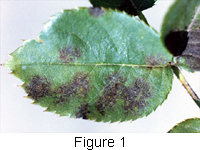Marie A. C. Langham,
South Dakota State University
Valentine’s Day offers us the opportunity to celebrate the people who bring love and care into our lives. A favorite way to do this is to send someone roses. Of the over 1.2 billion cut roses sold each year, more than 1.3 million of them are delivered for Valentine’s Day. Potted roses and bush roses add to the numbers of roses that are given as Valentine’s Day gifts. Valentine roses of every color and description pour from florists’ shops and nurseries each year. However, certain plant pathogens also like roses too, and each year, they attack, deform, and destroy many roses.
Pathogens of roses are a widely varied group with diverse effects. One of the best know of these pathogens is Diplocarpon rosae, the fungus that causes black spot of rose. This disease is recognized by its black leaf spots with spreading borders (Figure 1). Leaves infected by D. rosae may turn yellow and fall from the stem. This is due to ethylene production by the fungus combined with a decrease in auxins produced by the plant. Lesions spread from leaves to the canes and onto petioles, peduncles, fruits, and sepals. Flecking and distortion may be found on the flower petals marring their appearance.
|

|
Botrytis blight is another plant disease that can ruin the beauty of a rose (Figure 2). Botrytis cinerea is a fungus that seriously damages roses, particularly during shipping and storage. High moisture conditions used in rose shipping and storage cause Botrytis blight to rapidly progress even when it was not visible on the flowers when they were cut. Petals will show small brown lesions that rapidly progress into a soft rot. During humid weather conditions, garden roses may also be infected. Infected buds will brown and wither often becoming covered with fuzzy gray mycelium.
Viruses and bacteria also infect roses. Rose mosaic (Figure 3) is a classic example of a viral disease in rose and can be distinguished by its classic line pattern symptom. Crown gall (Figure 4), caused by Agrobacterium tumefaciens, induces large, tumor-like growths to form on the plant due to the insertion of tumor-inducing DNA into the rose genome.
Prevention and control of the pathogens that infect roses adds to the cost of rose production and are among the determining factors in the supply of roses and rose bushes that are available. By working to control these diseases, plant pathologists are helping to preserve America’s passion for roses and to also ensure that we all receive our Valentine surprise since “A rose by any other name may smell as sweet,” but a rose infected by a pathogen is no one’s treat.
For more information on rose diseases, try the following sources:
